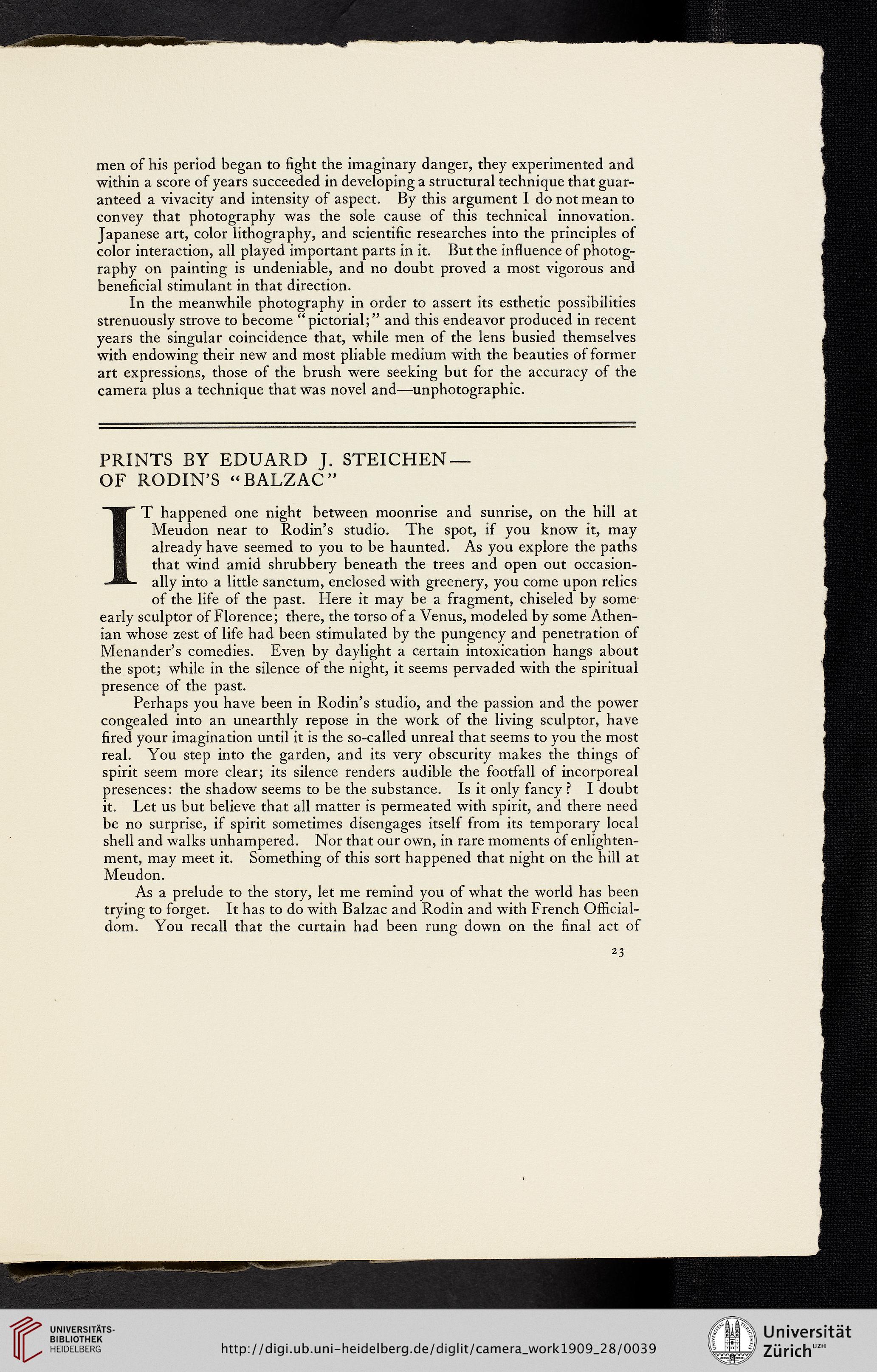Für diese Seite ist auch eine manuell angefertigte Transkription bzw. Edition verfügbar. Bitte wechseln Sie dafür zum Reiter "Transkription" oder "Edition".
men of his period began to fight the imaginary danger, they experimented and
within a score of years succeeded in developing a structural technique that guar-
anteed a vivacity and intensity of aspect. By this argument I do not mean to
convey that photography was the sole cause of this technical innovation.
Japanese art, color lithography, and scientific researches into the principles of
color interaction, all played important parts in it. But the influence of photog-
raphy on painting is undeniable, and no doubt proved a most vigorous and
beneficial stimulant in that direction.
In the meanwhile photography in order to assert its esthetic possibilities
strenuously strove to become “ pictorial;” and this endeavor produced in recent
years the singular coincidence that, while men of the lens busied themselves
with endowing their new and most pliable medium with the beauties of former
art expressions, those of the brush were seeking but for the accuracy of the
camera plus a technique that was novel and—unphotographic.
PRINTS BY EDUARD J. STEICHEN —
OF RODIN’S “BALZAC”
IT happened one night between moonrise and sunrise, on the hill at
Meudon near to Rodin’s studio. The spot, if you know it, may
already have seemed to you to be haunted. As you explore the paths
that wind amid shrubbery beneath the trees and open out occasion-
ally into a little sanctum, enclosed with greenery, you come upon relics
of the life of the past. Here it may be a fragment, chiseled by some
early sculptor of Florence; there, the torso of a Venus, modeled by some Athen-
ian whose zest of life had been stimulated by the pungency and penetration of
Menander’s comedies. Even by daylight a certain intoxication hangs about
the spot; while in the silence of the night, it seems pervaded with the spiritual
presence of the past.
Perhaps you have been in Rodin’s studio, and the passion and the power
congealed into an unearthly repose in the work of the living sculptor, have
fired your imagination until it is the so-called unreal that seems to you the most
real. You step into the garden, and its very obscurity makes the things of
spirit seem more clear; its silence renders audible the footfall of incorporeal
presences: the shadow seems to be the substance. Is it only fancy ? I doubt
it. Let us but believe that all matter is permeated with spirit, and there need
be no surprise, if spirit sometimes disengages itself from its temporary local
shell and walks unhampered. Nor that our own, in rare moments of enlighten-
ment, may meet it. Something of this sort happened that night on the hill at
Meudon.
As a prelude to the story, let me remind you of what the world has been
trying to forget. It has to do with Balzac and Rodin and with French Official-
dom. You recall that the curtain had been rung down on the final act of
23
within a score of years succeeded in developing a structural technique that guar-
anteed a vivacity and intensity of aspect. By this argument I do not mean to
convey that photography was the sole cause of this technical innovation.
Japanese art, color lithography, and scientific researches into the principles of
color interaction, all played important parts in it. But the influence of photog-
raphy on painting is undeniable, and no doubt proved a most vigorous and
beneficial stimulant in that direction.
In the meanwhile photography in order to assert its esthetic possibilities
strenuously strove to become “ pictorial;” and this endeavor produced in recent
years the singular coincidence that, while men of the lens busied themselves
with endowing their new and most pliable medium with the beauties of former
art expressions, those of the brush were seeking but for the accuracy of the
camera plus a technique that was novel and—unphotographic.
PRINTS BY EDUARD J. STEICHEN —
OF RODIN’S “BALZAC”
IT happened one night between moonrise and sunrise, on the hill at
Meudon near to Rodin’s studio. The spot, if you know it, may
already have seemed to you to be haunted. As you explore the paths
that wind amid shrubbery beneath the trees and open out occasion-
ally into a little sanctum, enclosed with greenery, you come upon relics
of the life of the past. Here it may be a fragment, chiseled by some
early sculptor of Florence; there, the torso of a Venus, modeled by some Athen-
ian whose zest of life had been stimulated by the pungency and penetration of
Menander’s comedies. Even by daylight a certain intoxication hangs about
the spot; while in the silence of the night, it seems pervaded with the spiritual
presence of the past.
Perhaps you have been in Rodin’s studio, and the passion and the power
congealed into an unearthly repose in the work of the living sculptor, have
fired your imagination until it is the so-called unreal that seems to you the most
real. You step into the garden, and its very obscurity makes the things of
spirit seem more clear; its silence renders audible the footfall of incorporeal
presences: the shadow seems to be the substance. Is it only fancy ? I doubt
it. Let us but believe that all matter is permeated with spirit, and there need
be no surprise, if spirit sometimes disengages itself from its temporary local
shell and walks unhampered. Nor that our own, in rare moments of enlighten-
ment, may meet it. Something of this sort happened that night on the hill at
Meudon.
As a prelude to the story, let me remind you of what the world has been
trying to forget. It has to do with Balzac and Rodin and with French Official-
dom. You recall that the curtain had been rung down on the final act of
23


